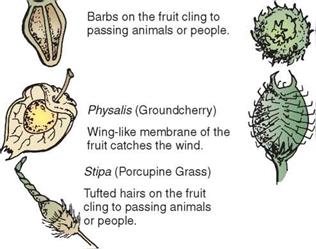Being plants, weeds share the binomial nomenclature of botanical classification. All are classified into families, genera, species, and varieties. Also, like other plants, weeds are classified in other ways. Their place of growth may classify them as aquatic or terrestrial. Their leaf type may classify them as grasses or broad leaved. They may also be categorized as herbaceous or woody or as annuals, biennials, or perennials. These terms were defined in Chapter 2.
The Origin and Dissemination of Weeds Even when the climate is hot and dry, or the soil infertile, weeds seem to proliferate. They can appear in a raised greenhouse bench or beside a containerized street tree. They are as apt to be found in a manicured lawn as in a cultivated flower bed. Frustrated gardeners through the centuries have pondered how the weedy pests invade their crops.
Historically, the origin and distribution of weeds in an area have paralleled migration and colonization by early settlers. Many of our North American weeds came from Europe. No doubt there were weed seeds aboard the Mayflower. Certainly the Forty-Niners carried a good assortment of weeds with them aboard their wagons as they rolled westward.
Within a local area, weeds are distributed as seeds or other reproductive parts such as stolons, roots, bulbs, rhizomes, or tubers. Cultivated soil is likely to have a greater number and diversity of weeds than uncultivated land due to the dissemination of propagative parts by cultivating tools.
Many agents of dissemination account for the dispersal of weeds. They may be natural or artificial. Some natural agents of dissemination are:
• flowing water
• wind
• birds
• livestock and other animals
• forceful dispersal of seeds from pods or capsules
Some artificial agents of dissemination are:
• cultivating tools
• vehicles
• clothing
• transplanting desired plants from one area to another and moving weeds with them
Gardeners who work manure from the local stockyard into their soil may be planting weed seeds from fodder that originated far away. Landscapers who use inexpensive seed to develop a lawn may be planting more weed seeds than quality grasses. Greenhouse growers who permit the maturation of a few Oxalis under the greenhouse benches will soon find them growing above the benches as their pods split (dehisce) and forcefully eject seeds over a considerable distance. Homeowners who pull a wild morning glory or field bindweed from the shrub bed
leave behind segments of the root system destined to reproduce the plant vegetatively a hundredfold.
Weeds have evolved to survive. They are prolific seed producers, with some species capable of producing more than a million seeds per parent plant. As with nonweed plants, some weed seeds germinate quickly and easily, while others remain dormant longer. Weed seeds are usually distributed throughout a soil’s profile, so turning over the earth may bring to the surface seeds that have been buried and dormant for several years.
Weed seeds and fruits usually benefit from a morphological development that ensures their successful dissemination (Figure 6-14). Assorted appendages that catch the wind like sails or latch onto the clothing or fur of passing humans or animals provide transport over long distances. Hard seedcoats allow safe passage of the seeds through the digestive tract of birds and livestock to be deposited with the manure. Some weed seeds are even able to plant themselves. Their wedge-like appendages
|
|
|
|
|
|
 |
|
|
|
|
|
|
|
|
|
|
|
|
|
|
|
|
|
|
|
|



figure 6-14. Devices produced by weed seeds and fruits that assure their dissemination (Delmar/Cengage Learning)
respond to alternating moisture levels in the soil and air by literally burrowing into the loose soil. Each change in the moisture state thrusts the seed deeper until it is completely buried.



